| Origin | Spinalis capitis: spinous processes of C6-T2 vertebrae or nuchal ligament Spinalis cervicis: spinous processes of C7-T1 vertebrae or nuchal ligament Spinalis thoracis: spinous processes of T11-L2 vertebrae |
| Insertion | Spinalis capitis: occiput Spinalis cervicis: spinous processes of C2 or C3 vertebrae Spinalis thoracis: spinous processes of T2-T8 vertebrae |
| Action | Bilateral contraction: extension of the trunk and neck (at cervical and thoracic spine) Unilateral contraction: lateral flexion of the trunk and neck (at cervical and thoracic spine) |
| Nerve | Posterior rami of the lumbar, thoracic, and cervical nerves |
| Artery | Dorsal branches of the posterior intercostal artery, deep cervical artery, muscular branches of vertebral artery |
Location & Overview
The spinalis muscle is situated in the middle and upper back as well as the neck, running parallel to the spine. It plays an important role in extending the back and neck, while also aiding in lateral flexion movements. The spinalis muscle is a member of the erector spinae muscle group. The erector spinae muscles consist of the spinalis, iliocostalis, and the longissimus. The erector spinae muscles are deep muscles of the back which run in a vertical direction, parallel to the vertebral column. The spinalis is the most medial of these muscles and blends with longissimus thoracis laterally.[1]
The spinalis muscle is also comprised of three sections, the capitis, cervicis and thoracis. The capitis is the most superior of these sections, the cervicis is in the middle, and the thoracis is the most inferior [2]. The spinalis’ cervicis and capitis portions also have variations between people. Some people may have a cervicis and capitis which is blended with the semispinalis muscle, some people may have a distinct cervicis and capitis which does not blend into the semispinalis muscle, and some people may be missing one of both of these muscle portions entirely or it may be present on just one side. More details about this can be found in the origin and insertion section below [3].
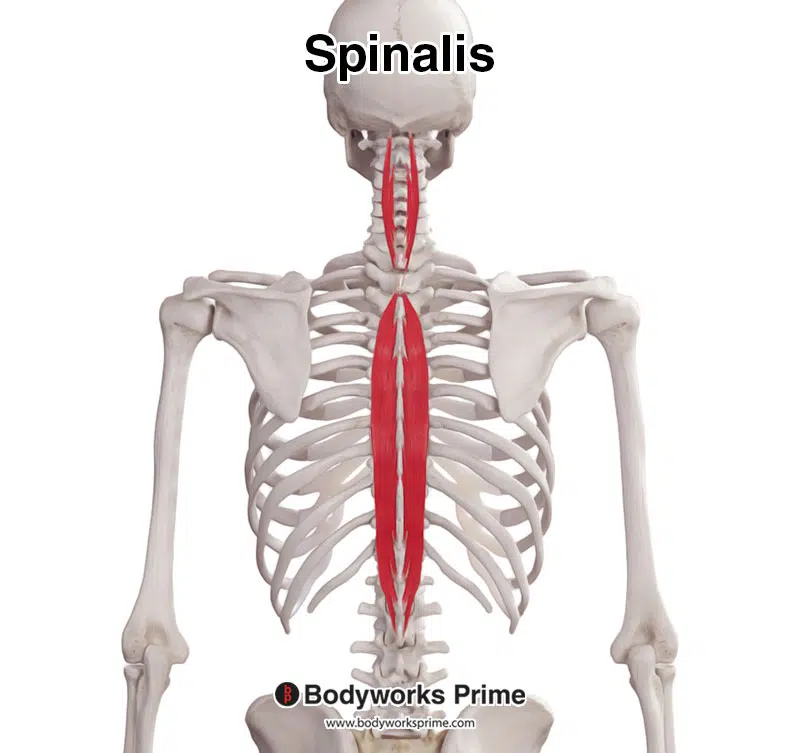
Pictured here, we can see the spinalis muscle by itself.
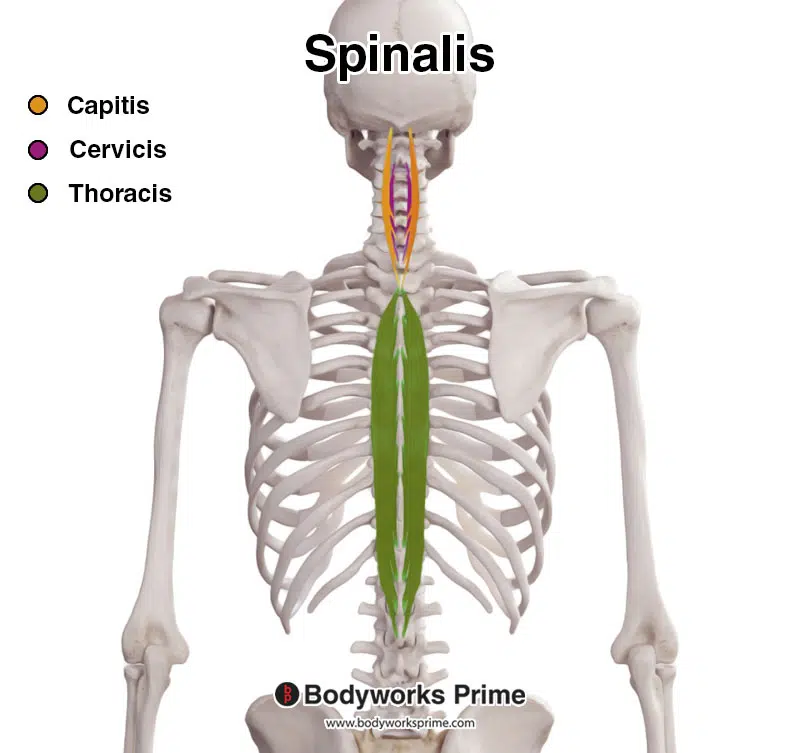
This picture shows the different sections of the spinalis muscle. The capitis is highlighted in yellow, the cervicis purple, and thoracis green.

Displayed here are the erector spinae muscles, without any color coding or labels.
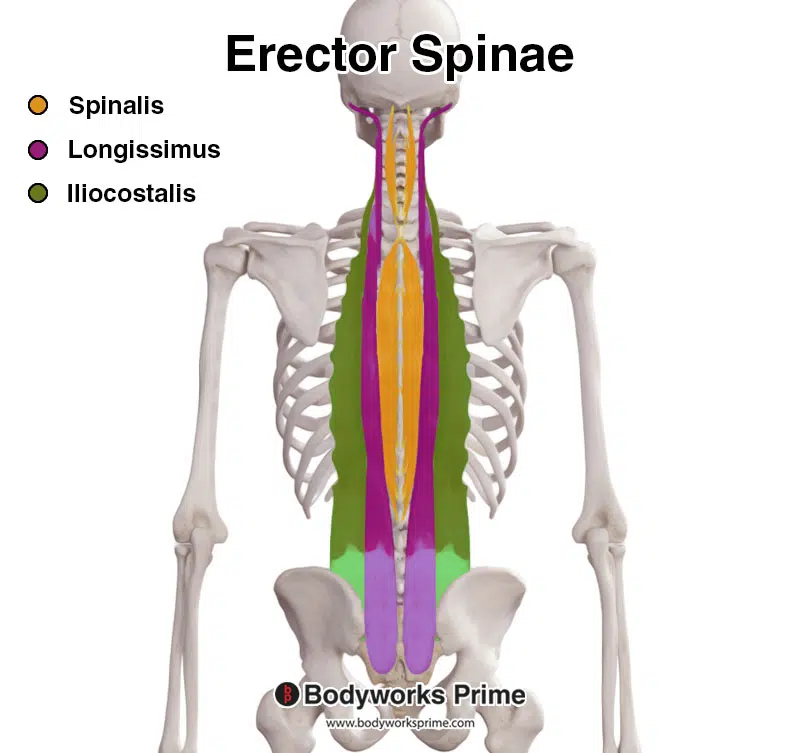
Here we can see each of the erector spinae highlighted in different colours for clarity. The spinalis is highlighted in yellow, the longissimus in purple, and the iliocostalis in green.
Origin & Insertion
The spinalis muscle’s origin and insertions are different for each section of the muscle. There are also individual variations between people as outlined below:
The spinalis thoracis originates on the spinous processes of T11-L2 and inserts onto the spinous processes of the upper thoracic vertebra of T2-T8 [4].
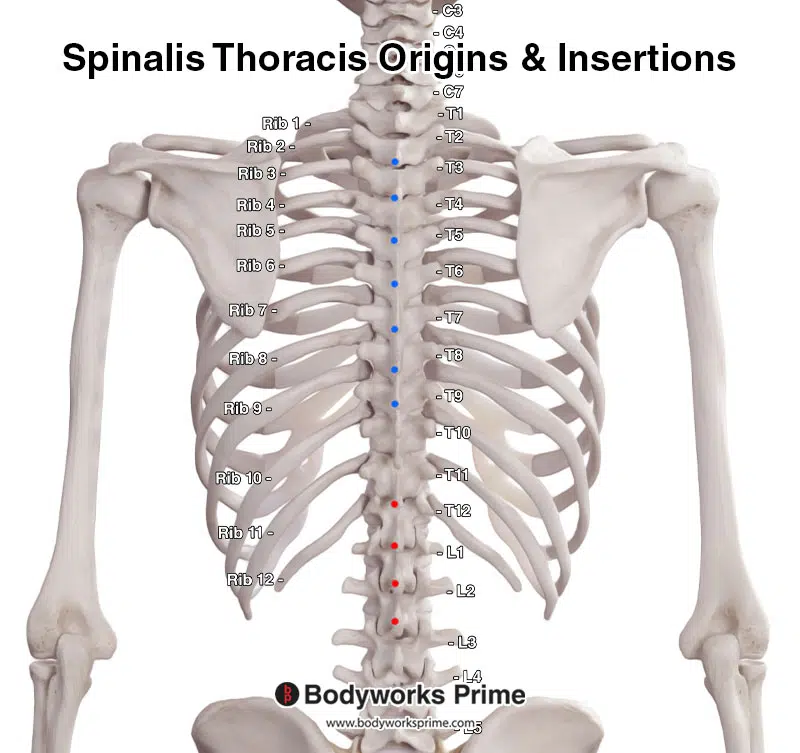
In this image, we can observe the origin and insertion points of the spinalis thoracis muscle. The origins are highlighted in red, while the insertions are colored blue.
Note: For the sake of simplicity, only the left side of the muscle is displayed here. However, the origins and insertions are duplicated on the right-hand side as well.
The spinalis cervicis muscle originates from the nuchal ligament or the spinous processes of the lower cervical to upper thoracic vertebrae (C7 and T1) and inserts onto the spinous processes of the second or third cervical vertebra. This muscle is distinct and separate from the semispinalis capitis in 46.1% of individuals. However, in 18% of cases, the fibers of the spinalis cervicis are blended with those of the semispinalis cervicis. In such instances, the spinalis cervicis originates from the same location, but the fibers blend with those of the semispinalis cervicis before inserting onto the spinous processes of C2 or C3. In 35.9% of individuals, the spinalis cervicis muscle is entirely absent [5].
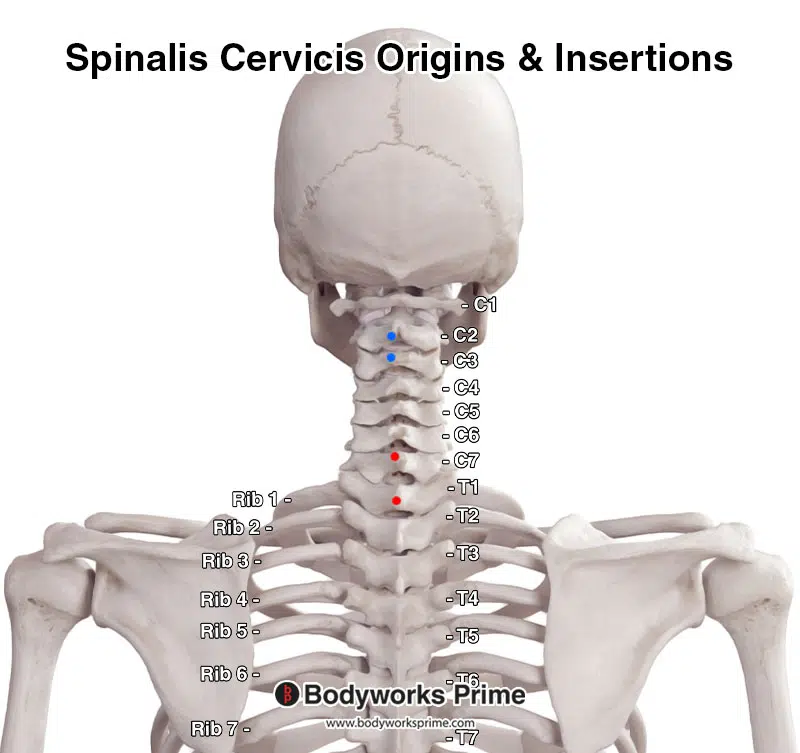
This image shows the origin and insertion sites of the spinalis cervicis section. The red markings indicate the muscle’s origins, while the blue markings represent its insertions.
Note: For the sake of simplicity, only the left side of the muscle is displayed here. However, the origins and insertions are duplicated on the right-hand side as well.
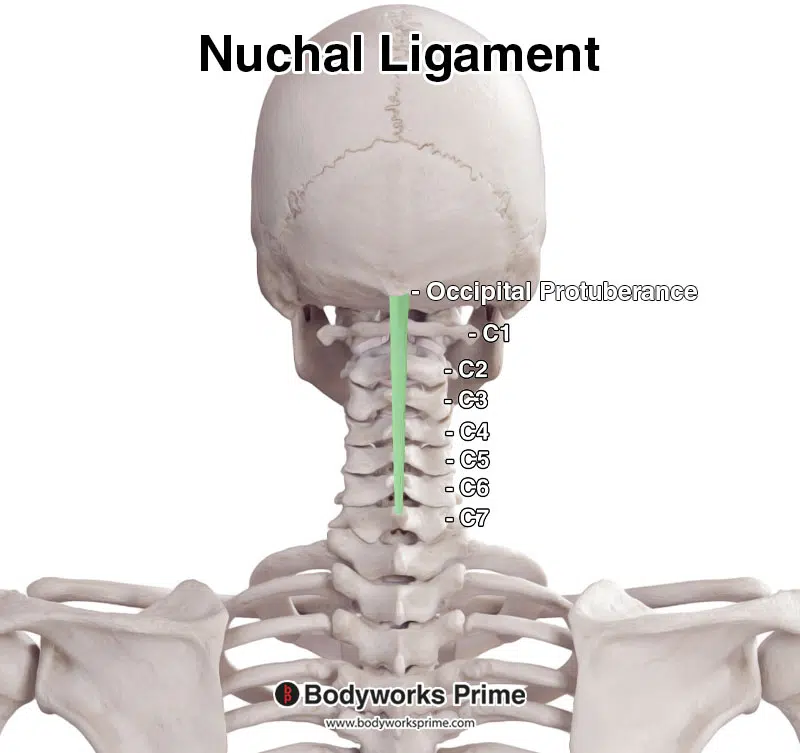
This image displays the nuchal ligament, which serves as a point of origin for the spinalis cervicis and spinalis capitis sections. The nuchal ligament, located at the back of the neck, and extends from the external occipital protuberance to the seventh cervical vertebra.
The spinalis capitis muscle originates from the spinous processes of C6 to T2 or the associated nuchal ligament and inserts onto the occiput. This muscle is distinct and separate from the semispinalis capitis in 1% of individuals. However, in 28.7% of cases, the fibers of the spinalis capitis are blended with those of the semispinalis capitis. In such instances, the spinalis capitis still originates from the spinous processes of C6 to T2 or the associated ligamentum nuchae, but the fibers blend with those of the semispinalis capitis before inserting onto the occiput. The spinalis capitis muscle is absent entirely in 70.3% of people [6].
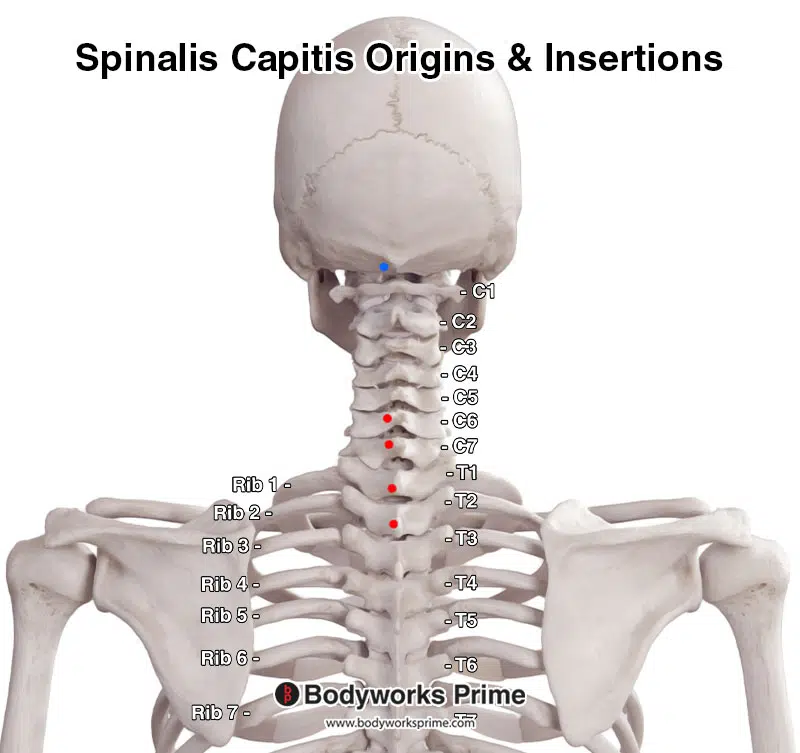
Displayed here are the origin and insertion points of the spinalis capitis muscle. The muscle’s origins are marked in red, and its insertions are marked in blue.
Note: For the sake of simplicity, only the left side of the muscle is displayed here. However, the origins and insertions are duplicated on the right-hand side as well.
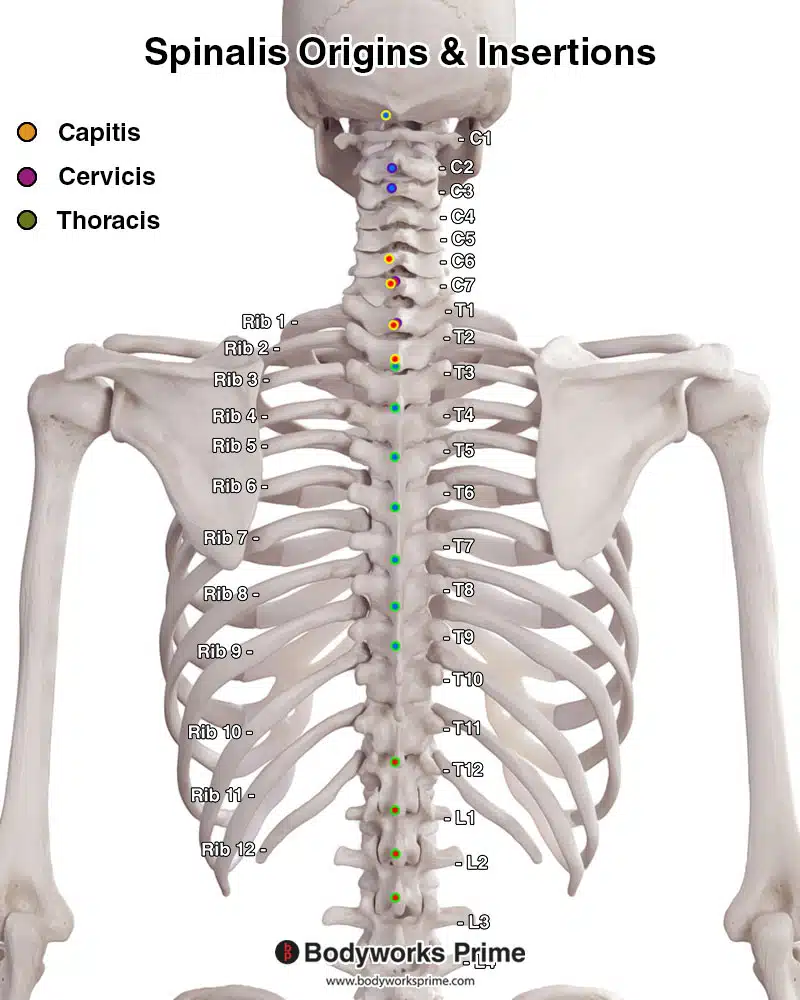
Pictured here are the origins and insertions of the spinalis thoracis, cervicis, and capitis, with origins highlighted in red and insertions in blue. The capitis has a yellow highlight around it, the cervicis has a purple highlight and the thoracis has a green highlight.
Note: For the sake of simplicity, only the left side of the muscle is displayed here. However, the origins and insertions are duplicated on the right-hand side as well.
Actions
The actions of the spinalis muscle vary based on which portion is contracting and whether one side or both sides of the muscle contract simultaneously. Unilateral contraction refers to the contraction of one side, while bilateral contraction refers to the contraction of both sides together [7].
The thoracis section spans from L2 to T2 and affects the vertebrae in this area. Bilateral contraction results in trunk extension, while unilateral contraction causes lateral flexion of the trunk [8].
The cervicis portion, located between T1 and C2/C3, influences the corresponding vertebral region. Bilateral contraction leads to extension of the cervical vertebrae, thereby extending the neck. Unilateral contraction, on the other hand, causes ipsilateral lateral flexion of the neck [9].
Similarly, the spinalis capitis segment stretches from T2 to the occiput and also affects the cervical vertebrae. Bilateral contraction results in neck extension, while unilateral contraction causes ipsilateral lateral flexion of the neck [10].
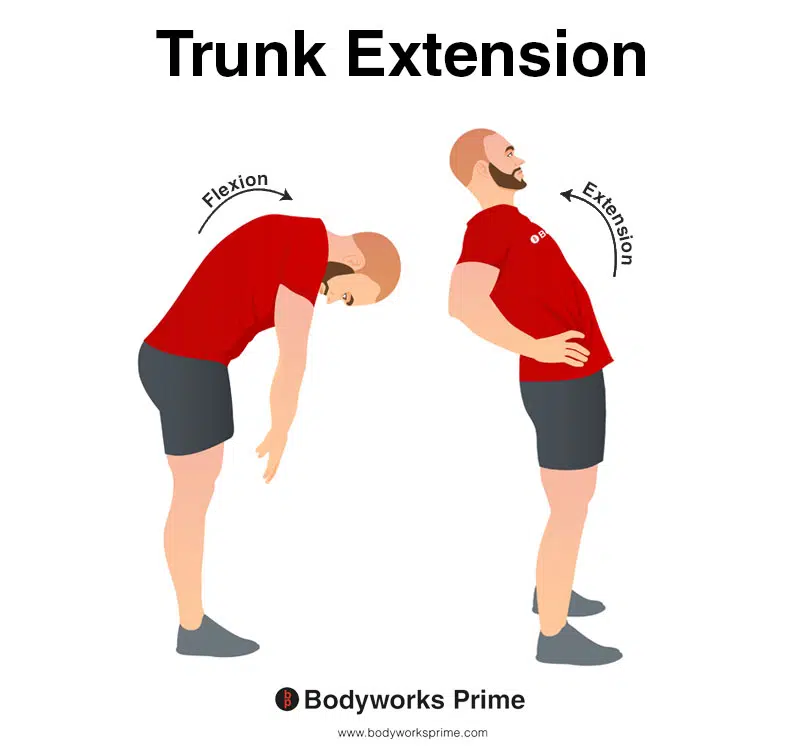
This image shows an example of trunk extension, which involves arching or bending the spine/torso/back backwards. The opposite of trunk extension is trunk flexion. The spinalis thoracis section is involved in trunk extension. The extension is the result of a bilateral contraction.

This image demonstrates trunk lateral flexion, which involves bending the torso to the side. The spinalis thoracis section is involved in trunk lateral flexion. The lateral flexion is the result of a unilateral contraction.

This image demonstrates neck extension, which involves bending the neck backwards. The opposite of neck extension is neck flexion. The spinalis cervicis and capitis sections are involved in neck extension. The extension is the result of a bilateral contraction.
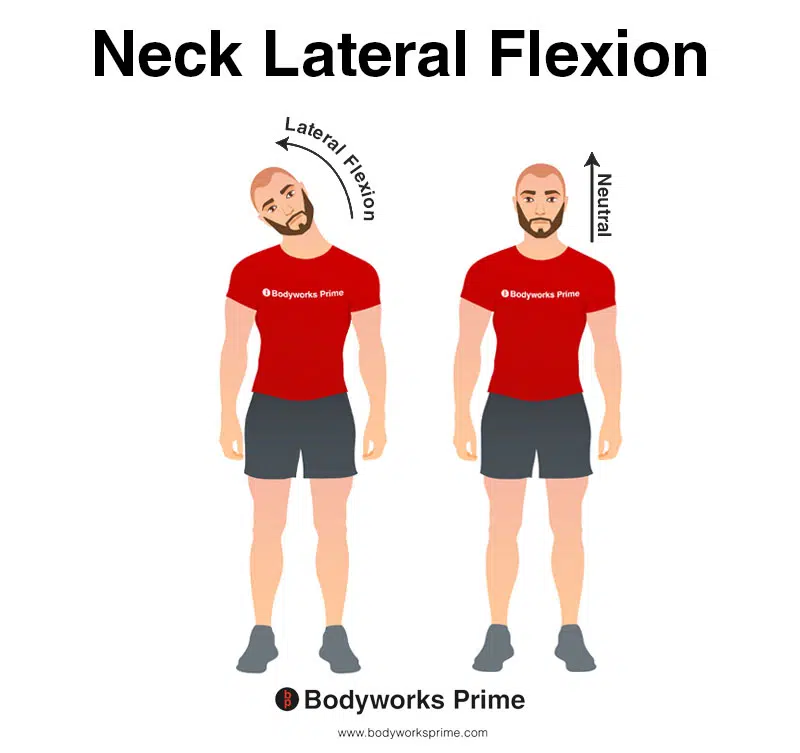
This image demonstrates neck lateral flexion, which involves bending the neck to the side. The spinalis cervicis and capitis sections are involved in neck lateral flexion. The lateral flexion is the result of a unilateral contraction.
Innervation
The thoracic portion of the spinalis muscle is innervated by the posterior rami of the thoracic and upper lumbar nerves. The cervicis and capitis portions are innervated by the posterior rami of the cervical and upper thoracic nerves.

Pictured here is a cross-section of a lumbar vertebra. One of the labeled parts is the ‘dorsal ramus’, which is also known as the ‘posterior ramus’. Each segment of the erector spinae muscles receives innervation from the posterior ramus of the corresponding spinal nerve. In other words, the part of the muscle aligned with a specific spinal segment is innervated by that specific spinal nerve’s posterior ramus.
Blood Supply
The spinalis muscle is supplied with blood by the dorsal branches of the posterior intercostal artery, the deep cervical artery, and the muscular branches of the vertebral artery.
Want some flashcards to help you remember this information? Then click the link below:
Spinalis Flashcards
Support Bodyworks Prime
Running a website and YouTube channel can be expensive. Your donation helps support the creation of more content for my website and YouTube channel. All donation proceeds go towards covering expenses only. Every contribution, big or small, makes a difference!
References
| ↑1, ↑2, ↑4 | Henson B, Kadiyala B, Edens MA. Anatomy, Back, Muscles. [Updated 2022 Aug 25]. In: StatPearls [Internet]. Treasure Island (FL): StatPearls Publishing; 2022 Jan-. Available from: https://www.ncbi.nlm.nih.gov/books/NBK537074/ |
|---|---|
| ↑3, ↑5, ↑6 | Greiner TM, Bedford ME, Walker RA. Variability in the human m. spinalis capitis and cervicis: frequencies and definitions. Ann Anat. 2004 Apr;186(2):185-91. doi: 10.1016/S0940-9602(04)80039-6. PMID: 15125051. |
| ↑7, ↑8, ↑9, ↑10 | Moore KL, Agur AMR, Dalley AF. Clinically Oriented Anatomy. 8th ed. Philadelphia: Lippincot Williams & Wilkins; 2017. |










